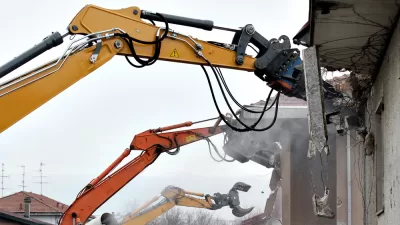Removing Detroit’s blight is highly emotional, and made more difficult by the lack of models for emulation. A recent editorial rejects the assumption that removing blight from over 100,000 vacant lots is sufficient to stimulate economic development.
After acknowledging that “[the] blight removal task force bankrolled by the federal government under the leadership of Gilbert’s Rock Ventures has set up an amazing process for mapping the city’s condition,” a recent editorial by John Gallagher pushes back on the argument that blight removal, by itself, will create economic opportunities in Detroit.
Maggie DeSantis, quoted in the article, invokes the eyeball test for the efficacy of blight removal in catalyzing economic development in Detroit: “If knocking down blight and clearing property was really the answer, then you’d already be seeing it.”
Gallagher goes on to raise the unanswered questions of Detroit’s current blight inventory and removal processes: “The short-term concerns focus on how demolition of tens of thousands of eyesore structures will take place in a short period of time. Will the debris be hauled away to landfills or dumped in the basements in a way that will create problems for future redevelopment? Will there be any attempt to salvage wood and other useful products to create a deconstruction industry in the city? Will city residents or outsiders get the jobs?”
Gallagher’s argument assumes that the ideas proposed by the Detroit Future City vision plan, which he describes as “innovative ways to repurpose urban land in the absence of development pressure,” are far from being actualized.
FULL STORY: John Gallagher: You tear down the blight in Detroit, but then what?

Planetizen Federal Action Tracker
A weekly monitor of how Trump’s orders and actions are impacting planners and planning in America.

Maui's Vacation Rental Debate Turns Ugly
Verbal attacks, misinformation campaigns and fistfights plague a high-stakes debate to convert thousands of vacation rentals into long-term housing.

San Francisco Suspends Traffic Calming Amidst Record Deaths
Citing “a challenging fiscal landscape,” the city will cease the program on the heels of 42 traffic deaths, including 24 pedestrians.

Amtrak Rolls Out New Orleans to Alabama “Mardi Gras” Train
The new service will operate morning and evening departures between Mobile and New Orleans.

The Subversive Car-Free Guide to Trump's Great American Road Trip
Car-free ways to access Chicagoland’s best tourist attractions.

San Antonio and Austin are Fusing Into one Massive Megaregion
The region spanning the two central Texas cities is growing fast, posing challenges for local infrastructure and water supplies.
Urban Design for Planners 1: Software Tools
This six-course series explores essential urban design concepts using open source software and equips planners with the tools they need to participate fully in the urban design process.
Planning for Universal Design
Learn the tools for implementing Universal Design in planning regulations.
Heyer Gruel & Associates PA
JM Goldson LLC
Custer County Colorado
City of Camden Redevelopment Agency
City of Astoria
Transportation Research & Education Center (TREC) at Portland State University
Jefferson Parish Government
Camden Redevelopment Agency
City of Claremont





























